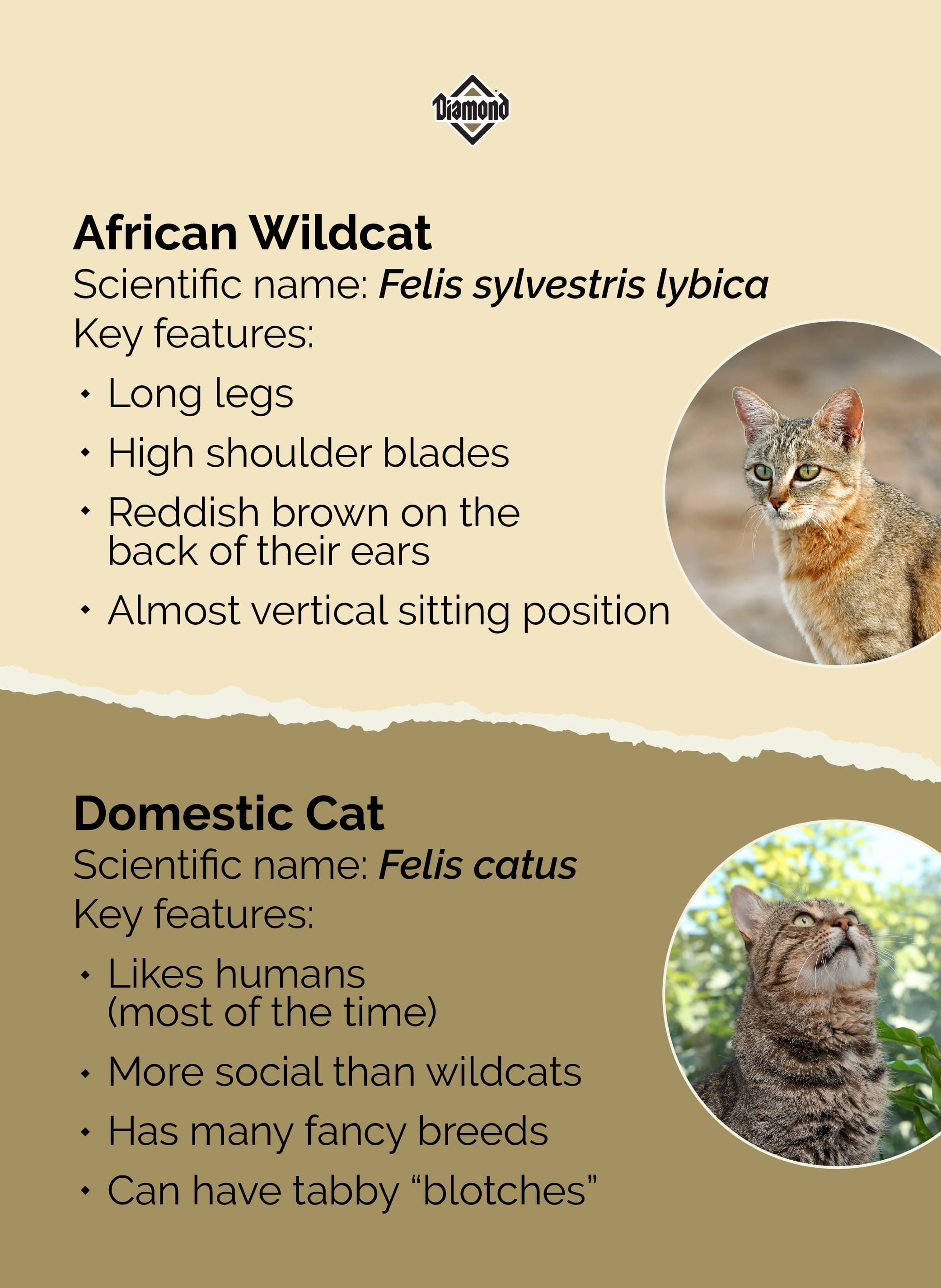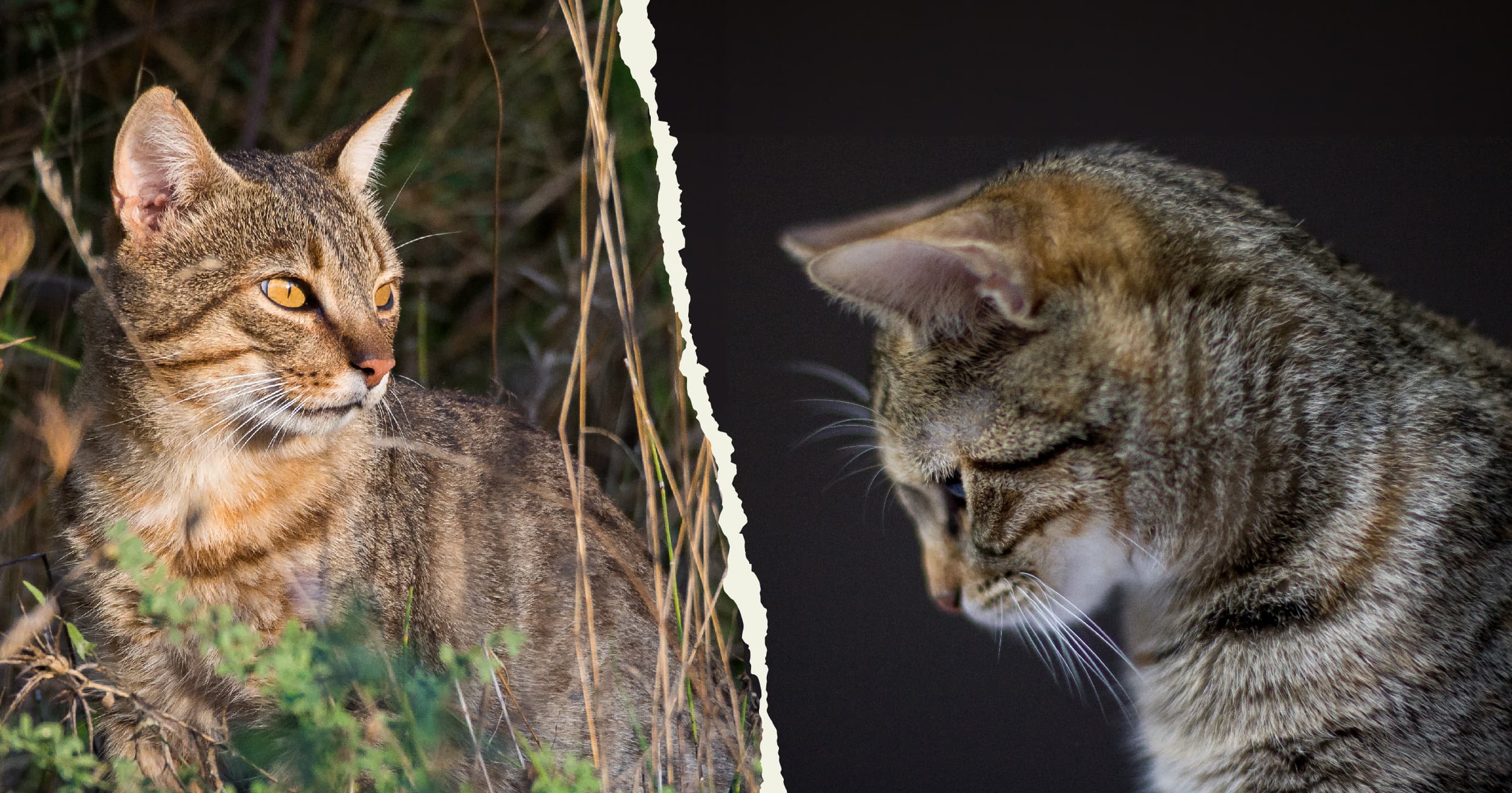Housecats are served food in a bowl, but most still love to hunt, stalk and kill “prey” (e.g., their wind-up mouse). So where does your cat get those wild instincts? A lion, a tiger or maybe a cheetah? Turns out your cat’s wild instincts come from … wait for it … a wildcat. Learn more about these ancient cats and how we know that they’re your cat’s great-great-great-great-great (times a bajillion) grandparents.
Wildcat Roots in Bones and Tooths
The ancestor of all domestic cats is a small cat called the African wildcat (Felis silvestris lybica). How do we know this? From scientists studying the DNA of ancient cats. One of these studies was published in Nature Ecology & Evolution and summarized in a nature news article and an animation. Whichever way you view the study, it’s interesting to learn what they discovered about the ancestors of our modern-day cats.
The team of scientists studied the mitochondrial DNA (DNA that’s inherited from the mother only) that was extracted from the bones and teeth of 209 cat remains found in places like Viking graves, Egyptian mummies and Stone Age sites. The cat remains ranged from between 15,000 years old (the Mesolithic age) to the eighteenth century and were from more than 30 archaeological sites across Europe, the Middle East and Africa.
The results point to domestication of the African wildcat happening in two waves. A Near Eastern lineage began during the Neolithic period and an Egyptian lineage spread thousands of years later. The scientists suggested that the patterns and ranges of the wildcats’ expansion were probably due to human trade routes and connectivity, both on land and water.
Farmers and Ratters Join Forces
As people learned how to farm during the Neolithic age and produced more grain than they could eat, they needed somewhere to store the grain. The study authors proposed that these grain stores attracted rodents which in turn attracted wildcats. The wildcats saw the benefit of living around humans (plenty of rodents to eat) and humans saw the benefit of having wildcats around (fewer rodents to eat their grain). The study results suggested that wildcat populations in the Near East expanded alongside early farming communities to the eastern Mediterranean (e.g., Bulgaria and Romania).
All Aboard (Including Cats)
Another wave of wildcat domestication started thousands of years later in Egypt. This lineage of wildcats spread throughout Eurasia and Africa and were found in Bulgaria, Turkey and sub-Saharan Africa from the end of the fourth century B.C. to the fourth century A.D. For several hundred years this lineage was more common than the Near East lineage.
It appears that Vikings also saw the benefit of having cats around (probably to keep those pesky rodents under control on ships). The researchers found cat remains descended from the Egyptian lineage at a Viking site in Ralswiek, northern Germany, that were dated between the eighth and eleventh century A.D.
The Tabby Appeared Later
The researchers also analyzed nuclear DNA (the DNA inherited from both parents) sequences that are known to produce the blotched coat colors of tabby cats that aren’t seen in wildcats. They found that this mutation didn’t occur until after the Middle Ages, and first appears in a cat sample from western Turkey dated from the fourteenth century at the latest. By the nineteenth century, when fancy breeding took off, the blotched coat color had become common. These results suggested to the researchers that people weren’t directly involved in breeding cats until later times compared to other domesticated animals.
Some More Wildcat Facts
Wildcats belong to the species Felis silvestris, which has five sub-species: European wildcat, Chinese mountain cat, South African wildcat, Asiatic wildcat and the African wildcat. According to the study authors, the African wildcat is the only sub-species to be successfully tamed.
If you look at pictures of African wildcats, you can clearly see the resemblance to house cats. But you can see some differences between the two when you look closer. The International Society for Endangered Cats (ISEC) Canada tells us that wildcats have longer legs, a more upright sitting posture and a different way of walking. When wildcats sit upright, their body is in an almost vertical position — a pose that’s nearly impossible for domestic cats to do. This same pose can be seen on ancienct Egyptian mummy cases and tomb paintings. The wildcat’s long legs and high shoulder blades make it move more like a cheetah than a housecat. Additionally, it has a reddish-brown on the back of its ears, whereas hybrids (domestic and wildcat crosses) usually have dark gray or black-backed ears.

Big Cats Are Just “Cousins”
So is there any connection between your cat and the “big” cats? Your cat is related to lions and, more closely, tigers, but it’s not as close as you may think. One study found that cats and Amur tigers share 95.6% of their genomes (DNA). By comparison, the genetic difference between humans, chimpanzees and bonobos is only 1.2%. So you are more closely related to a chimpanzee than your cat is to a tiger.
Now you know where those “wild” behaviors your cat likes to do come from. They’re channeling their inner wildcat. Do you think wildcats like to crawl into impossibly small spaces, too?
RELATED POST: Superstitions Are Why Black Cats Got Their Dark Reputations







